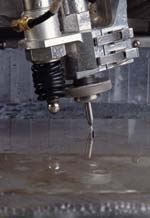Flange Cutting Challenges Overcome With New Waterjet Technology
One challenging application for this Ontario manufacturer has been cutting flanges. Previously, their customers had plasma-cut 1/2 -inch Hastalloy. However, plasma left a heat-affected zone that could be a problem when welding the flanges.
Share



Quality has always been a priority at Baumeier Waterjet Technology (Waterloo, Ontario). The company brings in a large percentage of its revenue by cutting cold-cut net or near-net parts from stainless steel, aluminum, copper, titanium, Inconel, hastalloy, composites and heat sensitive materials. These include aluminum alloys for the aerospace industry, gaskets, seals, instrument panels, carpets, door panels, bumpers and insulation for the automotive industry and other applications.
One challenging application has been cutting flanges. Previously, Baumeier's customers had plasma cut 1/2 -inch Hastalloy. However, plasma left a heat-affected zone that could be a problem when welding the flanges. The customer sometimes had to grind the surfaces or just deal with the poor edge quality the plasma left. The interior holes had to be opened up with a drill after the plasma cut, and the drills were not holding up to the hardened surface. However, according to Baumeier owner Otto Baumgaertner, the biggest challenge with customers using plasma was that they couldn't hold the accuracy and tolerances required for flanges, and the quality suffered because of the need for secondary processing.
Mr. Baumgaertner, who owned a conventional waterjet for several years, recently purchased the Dynamic Waterjet from Flow International Corporation (Kent, Washington). The Dynamic Waterjet is a cutting system that tilts the cutting head to produce more accurate parts at higher cutting speeds. In other words, the waterjet no longer remains fixed at a 90-degree angle to the plane of a flat plate but tilts automatically as required. By using computer models to control a small, articulated "wrist" cutting head, the new waterjet automatically adjusts cutting angles to cut parts at high accuracy and speed.
"Using the Dynamic Waterjet, we can now can cut the part to 0.005" at 100 percent of maximum cut speed, and find that the top-to-bottom of the part is virtually parallel," he says. "We are achieving excellent quality on the holes, the sides—the entire part. With conventional waterjet, we'd be cutting this part at approximately 20 to 40 percent, and we'd never get the job because the part cost would be too high. Dynamic Waterjet creates a perfect part with no heat-affected zone, no need for secondary grinding or drilling, no weld problems and no taper causing difficulty lining up the parts for welding. Now our parts fit together for customers better, and they are happy with the speed, quality, and price."
Mr. Baumgaertner has also found that he can cut at faster speeds while achieving optimal part quality.
"We cut at 60 to 80 percent of maximum cut speed with Dynamic Waterjet compared to 20 to 40 percent using the conventional waterjet. And the parts come off the machine with much better finished tolerance—usually to 0.005 inch. Parts cut at 80 percent with Dynamic Waterjet are top to bottom straighter than those cut at 40 percent with conventional waterjet. And the Dynamic Waterjet is especially effective when cutting holes and slots."
In addition to solving his flange-cutting challenges, Mr. Baumgaertner has found the new waterjet beneficial in other applications. For example, he notes that he used to have problems when using a conventional waterjet for stack cutting 12- to 13-gauge material.
"The parts were not all the same top to bottom. The part on the bottom would have a 0.005-inch variation from the top part, even cutting at 20 to 40 percent of maximum cut speed—the high quality settings. With Dynamic Waterjet, we cut at 60 to 80 percent of maximum cut speed while compensating for stream deflection, and the parts are the same from top to bottom—the square slots, round slots, holes and other shapes. We can maintain accuracy and repeatability throughout all the stacked parts."
Mr. Baumgaertner says he is also able to cut thicker applications using the new waterjet including 2 ½-inch thick die shoes and 1- to 2-inch thick stripper plates for the tool and die industry, as well as 2-inch thick 4140 components for the press industry. He says he could not cut these parts using a conventional waterjet because of the thickness of the pieces and inability to cut with the accuracy, squareness and quality required for these parts.
Mr. Baumgaertner also cites improvements in cutting aluminum parts. "The Dynamic Waterjet worked nicely when I cut 1-inch aluminum, which was cut at 60 percent of maximum cut speed. The shape had some small areas where it had to go into sharp corners. When I used conventional waterjet before to cut a precision part, I never knew what would happen with 1-inch material without a test cut."
Probably the most important factor impacting Baumeier's bottom line is the ability to expand into new markets because it is able to cut at faster speeds, produce more parts in fewer hours with greater accuracy and deliver a higher quality part to customers.
Related Content
4 Commonly Misapplied CNC Features
Misapplication of these important CNC features will result in wasted time, wasted or duplicated effort and/or wasted material.
Read MoreBallbar Testing Benefits Low-Volume Manufacturing
Thanks to ballbar testing with a Renishaw QC20-W, the Autodesk Technology Centers now have more confidence in their machine tools.
Read MoreAutomation is for Everyone
Not just for large shops, automation can help even the smallest shops solve labor challenges and become more profitable and efficient.
Read MoreAdditive/Subtractive Hybrid CNC Machine Tools Continue to Make Gains (Includes Video)
The hybrid machine tool is an idea that continues to advance. Two important developments of recent years expand the possibilities for this platform.
Read More



















.png;maxWidth=300;quality=90)










